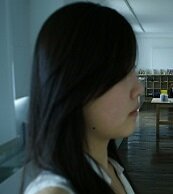Artist, Lee Ji Sun’s first story, ‘About the shadow’ 환영합니다, 이지선 작가님

Deer (left), A Bird in flight (right) – Henry Bursill(image source : www.shadow-puppets.com)
Images & Texts by Lee Ji Sun
Once the stars stop twinkling and the sleepy night ends, the morning comes in violet landscape. The light turns on. Light is the most essential element for all lives in the world. It allows us to see how does exterior view through the window look like, which faces do people carry passing by me and what does my handwriting figure. Then, it colors the world differently at each moment.
Just next to all shining things, there is a shadow which resembles them. Opposite to the brightness, shadow comes from the darkness and has been often used with negative meanings in cinema or literature, such as appearance of a fearful devil, presence of a criminal, or symbol of the death, for example. Despite these representations which may frighten us, it has also been a very friendly image, like shadow puppets that we enjoyed in the bed just before falling asleep.

Première présentation de l’ombre(video, 2010) – Lee Ji Sun(image source : Lee Ji Sun)
Psychologist Carl Jung depicted as shadow the positive or negative aspects of the personality, unconscious aspects which the conscious ego does not identify in itself. He also believed that we would realize the individuation process not by ignoring the shadow of ourselves but by reconciling it with our conscious ego. Shadows, like a child forever Peter Pan catches his ran away shadow and reattaches it under his shoes, disappear for a while then come back under its master’s area, follow and imitate next to him/her, or lead in the front.
Everything is flattened in shadow. It resembles to the object, but there’s neither facial expressions nor colors of clothes in the shadow. Using this characteristic, we’ve presented a dream-like scenes in shadow plays in both Western and Eastern cultures. Only following movements and voices of shadows, without fascinating costumes or make-ups, the spectators picture faces of characters and imagine more colorful backgrounds.

Le prince des joyaux(Les contes de la nuit, telefilm, 1992) – Michel Ocelot(image source : www.folimage.fr)
Going along with the scientific approaches, many artists and architects have studied these magical effects of light and shadow. László Moholy-Nagy, photographer as well as professor in the Bauhaus school, created a Light-Space Modulator, which occupies entirely the space with light and shadow effects. In sculpture, their changing direction and intensity make the same volume seem completely different. In architecture where the natural and artificial lighting is one of the most important elements, beginning with stained glasses, we find more and more experimental and playful structures harmonizing the light and its shadows.
Shadows are still used as interesting material of contemporary art in direct or indirect ways. They seem to trick or lie but project a reality. For example, British artists Tim Noble and Sue Webster sculpt a human shadow crafted from personal items or domestic trash, and Japanese artist Kumi Yamashita figure human profile shadows with creased paper. Avant-garde artist specializing in cinema film Anthony McCall plunged the spectators into simple but strong light projection and makes themselves a shadow.

Akari(installation view, 2009) – Kumi Yamashita(image source : www.kumiyamashita.com)
As there’s no shadow without light, the world without shadow would be too smooth and flat. Just like the balance between yin and yang, or the unlimited composition of black and white, the shadow gives contours to shiny lights and releases secret imaginary from the silhouette.

Portraits anonymes(cut paper installation, 2010) – Lee Ji Sun(image source : Lee Ji Sun)
Lee Ji Sun is a young Korean artist, who does activity in Paris, France. CultureM Magazine releases her art works images by drawing, writing, video, photograph in every month. http://leejisun.blogspot.kr/
이지선은 프랑스 파리를 중심으로 유럽에서 활동하는 젊은 한국여성작가이다. 회화, 비디오, 사진, 글 등의 다양한 매체로 작품활동을 하고 있는 그녀의 아트 웍을 소개한다. http://leejisun.blogspot.kr/
















Comments are closed